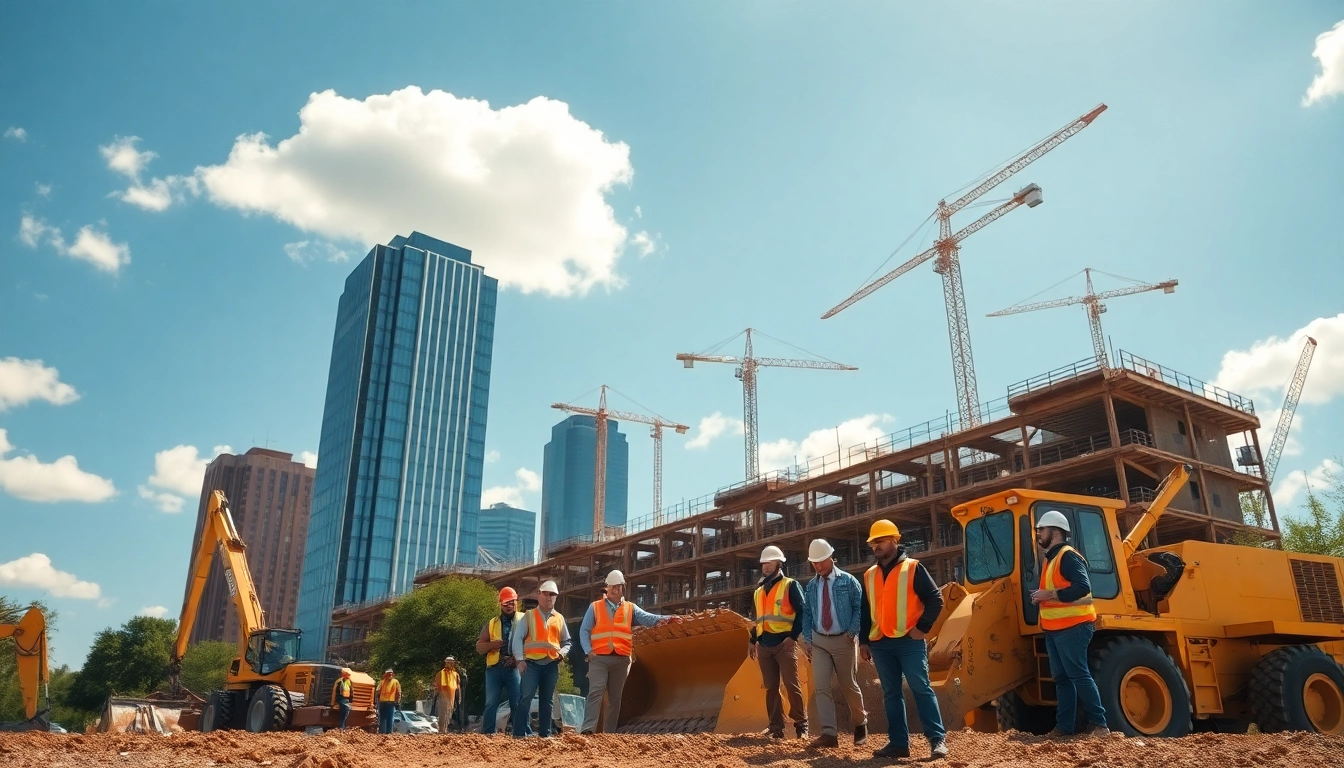Understanding the Austin Construction Landscape
The Austin construction sector is rapidly evolving, driven by a confluence of economic growth, demographic shifts, and technological advancements. This vibrant industry encompasses a variety of projects, from residential developments to large-scale commercial and infrastructure works. As key players adapt to the dynamic environment, it’s essential to dive deep into the current trends, the major stakeholders, and the regulatory challenges impacting the construction landscape in this thriving Texas city. For more resources, you can explore austin construction.
Current Trends in Austin Construction
Austin’s construction landscape is characterized by several key trends that reflect its unique market conditions:
- Green Building and Sustainability: Growing awareness of environmental issues has led to a surge in sustainable construction practices. Builders are increasingly integrating eco-friendly materials and energy-efficient technologies in their projects, aiming for certifications like LEED.
- Urban Revitalization: Many urban areas in Austin are undergoing revitalization, with developers focusing on mixed-use projects that meld residential, commercial, and recreational spaces. This trend caters to a growing urban population seeking vibrant communities.
- Technological Integration: Adoption of Building Information Modeling (BIM) and construction management software is transforming how projects are planned and executed, enhancing collaboration and efficiency.
- Affordable Housing Initiatives: The rising cost of living has prompted both the public and private sectors to embark on affordable housing projects, aiming to address the housing crisis effectively.
- Labor Shortages: A critical shortage of skilled labor in the industry has led to heightened competition among contractors, pushing them to innovate in workforce development and training.
Key Players in the Austin Construction Market
The Austin construction market is composed of various stakeholders, including general contractors, subcontractors, suppliers, and developers. The essential players include:
- General Contractors: They manage projects from conception to completion, overseeing subcontractors and ensuring adherence to timelines and budgets.
- Subcontractors: Specialists in specific trades (like electrical, plumbing, or HVAC) who execute particular project components under the direction of general contractors.
- Material Suppliers: Crucial for maintaining project flow by supplying necessary materials, equipment, and technology.
- Design and Engineering Firms: Provide essential planning and technical support, often working closely with contractors to ensure design specifications are met.
- Local Governments: Central to permitting, regulation, and community planning, influencing the construction process through zoning laws and safety standards.
Regulatory Environment Impacting Austin Construction
The regulatory framework governing construction in Austin comprises a myriad of local, state, and federal guidelines. Key regulatory aspects include:
- Zoning Laws: These dictate land use and density, significantly impacting where and how construction can take place.
- Building Codes: Safety and structural integrity standards that all construction projects must comply with ensure public safety and environmental preservation.
- Permitting: Complex permitting processes can lengthen the time required to initiate projects, impacting overall project timelines.
- Environmental Regulations: Compliance with regulations related to environmental protection, such as the Clean Water Act and Endangered Species Act, is imperative and often influences project planning.
Project Planning and Management in Austin Construction
Successful construction projects rely heavily on meticulous planning and management to ensure they meet client expectations while adhering to timelines and budgets. Below are essential aspects of effective project management in Austin’s construction sector.
Essential Steps for Successful Project Initiation
Effective project initiation involves several key steps to ensure a smooth operational flow:
- Defining Project Scope: Clearly outline project objectives, deliverables, and timelines to align all stakeholders’ expectations.
- Conducting Feasibility Studies: Analyze economic, legal, and operational feasibility to assess potential challenges and risks associated with the project.
- Creating a Project Plan: Develop comprehensive plans detailing timelines, resources, budget, and responsibilities to guide all project phases.
- Engaging Stakeholders: Include all significant stakeholders during the planning phase to gather input and foster buy-in.
Effective Team Collaboration Strategies
Effective collaboration among all team members is crucial for project success. Steps to enhance collaboration include:
- Utilizing Collaboration Tools: Implement digital tools (like project management software) that facilitate communication and track progress in real-time.
- Regular Team Meetings: Schedule consistent meetings to assess project progress, address challenges, and adjust plans as necessary.
- Fostering a Collaborative Culture: Encourage open communication and value diverse contributions to enhance team problem-solving and creativity.
Utilizing Technology in Austin Construction Projects
Technology is reshaping the construction landscape, leading to increased efficiency and innovation. Some technologies influencing project execution include:
- Building Information Modeling (BIM): Allows for 3D modeling of designs that enables better visualization and coordination among various project teams.
- Drones: Used for site surveying and monitoring, drones provide valuable aerial perspectives that improve accuracy and efficiency in project management.
- Prefabrication: Off-site construction allows for faster on-site assembly, resulting in reduced time frames and potentially lower costs.
- Project Management Software: Tools like Procore or PlanGrid streamline communication, document sharing, and project tracking, leading to enhanced organizational efficiency.
Challenges Faced by Austin Construction Professionals
The construction industry in Austin, while booming, is not without its challenges. Addressing these issues effectively is key to maintaining the momentum in project development.
Labor Shortages and Workforce Development
A significant challenge facing the construction industry is a persistent labor shortage. Strategies to address this issue include:
- Investment in Training Programs: Construction firms should invest in apprenticeship and training programs to attract younger workers and upskill existing employees.
- Collaborations with Educational Institutions: Partnering with trade schools and universities can create a pipeline of skilled labor that meets industry demands.
- Promoting Career Opportunities: Highlighting the merits of a construction career, including growth potential and benefits, can attract new talent to the industry.
Dealing with Supply Chain Disruptions
Disruptions in the supply chain can lead to project delays and increased costs. To mitigate these issues:
- Diverse Procurement Strategies: Sourcing materials from multiple suppliers reduces dependency on a single supplier and mitigates risks of shortages.
- Inventory Management: Implementing effective inventory management systems helps maintain adequate stock levels to buffer against supply chain fluctuations.
- Strengthening Relationships with Suppliers: Building strong relationships with suppliers can enhance communication and reliability, reducing the impact of potential disruptions.
Mitigating Environmental Impact in Austin Construction
As urban development increases, so does the necessity for responsible environmental stewardship. Strategies for minimizing environmental impact include:
- Conducting Environmental Assessments: Implementing comprehensive assessments to identify potential environmental impacts and strategies for mitigation is critical.
- Utilizing Sustainable Materials: Integrating recycled and eco-friendly materials can significantly lower a project’s carbon footprint.
- Implementing Waste Management Practices: Effective waste management strategies, including recycling and reusing materials, reduce landfill contributions.
Quality and Safety Standards in Austin Construction
Maintaining high-quality and safety standards is essential for protecting workers and ensuring successful project outcomes. Below are critical aspects of quality and safety in construction.
Adhering to Local and Federal Regulations
Compliance with various regulations is not negotiable in construction. Key regulations include:
- OSHA Standards: The Occupational Safety and Health Administration outlines safety standards that construction sites must follow to ensure worker safety.
- Building Codes: Local and state building codes set the standards for construction practices, requiring regular updates to align with advancements.
- Environmental Regulations: Compliance with environmental laws ensures that construction practices do not harm surrounding ecosystems.
Implementing Safety Best Practices
Effective safety measures include:
- Regular Training Sessions: Conducting regular safety training for all workers can instill a culture of safety and preparedness.
- Personal Protective Equipment (PPE): Ensuring all workers wear appropriate PPE is vital for minimizing injury risks on the job site.
- Incident Reporting Protocols: Establishing clear protocols for reporting and addressing safety incidents fosters accountability and continuous improvement.
Quality Assurance Strategies for Austin Construction Projects
Quality assurance is paramount to project success. Strategies include:
- Regular Inspections: Conducting frequent inspections during various construction phases ensures compliance with specifications and standards.
- Quality Control Plans: Implementing detailed plans that specify quality requirements helps in monitoring and improving process efficiencies and outcomes.
- Engagement with Stakeholders: Engaging clients and other stakeholders during the construction process helps maintain alignment on quality expectations.
The Future of Austin Construction: A Vision Ahead
Looking forward, the Austin construction landscape is expected to evolve dramatically, driven by innovations and shifts in market demand and demographics.
Innovations Shaping the Future of Austin Construction
A variety of emerging innovations are set to redefine construction practices, including:
- Advanced Materials: The development of smart materials that react to environmental changes can greatly enhance building performance and longevity.
- Automation and Robotics: Automation in construction processes, from robotic bricklaying to automated machinery, can significantly reduce labor costs and improve safety outcomes.
- VR and AR Technology: Virtual and augmented reality have begun to play roles in design visualization and training, providing immersive ways to engage clients and train workers.
Predicted Market Growth and Opportunities
The Austin construction market is projected to witness steady growth, fueled by population increases and economic development initiatives. Key growth areas include:
- Infrastructure Development: As the population grows, the need for robust infrastructure such as roads, bridges, and utilities becomes increasingly critical.
- Residential Construction: A substantial influx of new residents is driving demand for housing, particularly affordable options.
- Commercial Projects: The thriving tech and service sectors in Austin are leading to the construction of new office spaces, retail areas, and mixed-use developments.
Community Impact and Sustainability in Austin Construction
The construction industry has a profound impact on local communities. To create positive effects, construction firms must prioritize sustainable practices, such as:
- Community Engagement: Involving community stakeholders in planning aligns projects with local needs and values.
- Sustainable Development Practices: Incorporating sustainability into project designs, such as green spaces and energy-efficient systems, fosters community well-being.
- Economic Benefits: Local job creation and investment in community infrastructure can enhance quality of life and economic stability.


